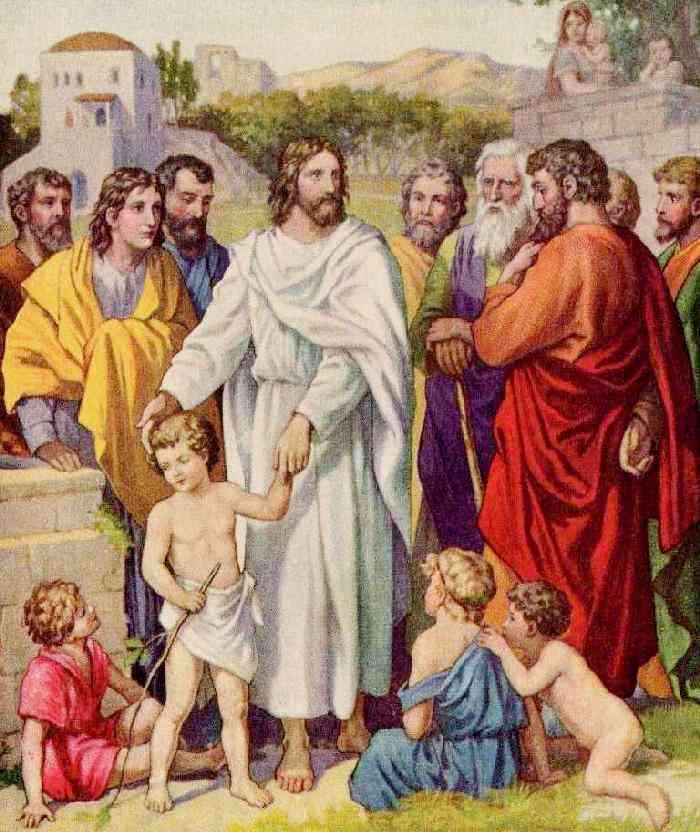
Ancient Hebrews: Children's Clothing

Figure 1.-- We are not yet sure who the illustrator was or when it was ceated in America , probably the early-20th century. It is the work of the sane illustrator who did the temple illustatio on the previous page. Here we see Jesus and the children (Mathew 9:13-15). The clothing of little children is largely imaginative, because the Bible provides virtually no informastion. One ewould think that simple tunics might be more likely than the garments shiwn here. We also think the bright colors are unlikely. Some Old Testament texts suggest that little children often did not wear clothes. That was the norm in Egypt, but it was almost certainly the case yjroughout Mediterranean countries and the Middle East.
|
|
Very little information available on what Hebrew adults wore. When it comes to children, there is virtually no definitive information avaiable. We know of one sculplture.
We know of only two Biblical referenves that we know.
We can, however, make some assumptions based on prevalent trends in ancient socities. Children generally wore clothing similar to the clothes worn by their parents. There may be some specific childhood garments, hair styles, or jewelry, but for the most part there were specifically childhood styles. Clothing was expensive at the time. Neasured as a share of income, mut more expensice than in modern times. Thus children climate permitting were more simply dressed than their parents. Younger children, especilly peasant childen probably commonly went naked in warm weaher. This was certainly the case in Egyot and unlike the case of the Hebrews there are many Egyptian paintings demonstaing this. It was almost certainly the case wih Hebrews as well.
This may have been more common for boys thn girls. Children wearing clothes probably wore tunics. We do not know if younger boys and girls dressed differently. It is unlikely that most clidren had cloaks as they would have been expensive. I am not sure about winter clothes. Children also commonly went brefoot considering the relatively high-cost of sandals which had leather soles.
Contemporary Art
As we have seen on the orevious page, Very little information is available on what Hebrew adults wore. When it comes to children, there is virtually no definitive information avaiable. We know of one sculplture. We note an Assyrian scuplture from the 8th century. Children are depicted with the adults. Perhaps readers will know of other contemporary artistic depictions. This is the only we know of. We would be very interested in any other contemporary artistic depictions readers have seen.
Biblical References
We know of only two Biblical references to children's clothes. Both are from the Old Testament. The first is Joseph's coat/tunic. Besides Joseph's tunic, the only garments mentioned by the Bible as worn by the a child are the "ephod" of Samuel: "Samuel ministered before the Lord, being a child, girded with a linen ephod" (1 Samuel 2:18) and the little "coat" that his mother made for him (2:19). Here the Hebrew term, ???? m‘il, can express several garments. The ephod, instead, was not a common garment. It was a sacerdotal garment, a sort of apron that priests wore over other vests (different from the great priest ephod). If the text is telling that Samuel ministered wearing only the ephod, this would be a confirm that a nearly naked child was not a problem even in the temple. The New Testament bis silent about children's clothing. There is very little about Jesus' childhoof in general. The
Gospels of Thomas and the Gospel of Nicodemus were not canoized and are thus part of the Apocrypha. They do describe the childhood of Jesus in much greater detail. Nor does the New Testament describe the clothing of other children.
Assumptions
We can make some assumptions based on prevalent trends in ancient socities. Children generally wore clothing similar to the clothes worn by their parents. There may be some specific childhood garments, hair styles, or jewelry, but for the most part there were specifically childhood styles. Clothing was expensive at the time. Measured as a share of income, clothing was much more expensice than in modern times. Thus children climate permitting were more simply dressed than their parents. Younger children, especilly peasant childen probably commonly went naked in warm weaher. This was certainly the case in Egyot and unlike the case of the Hebrews there are many Egyptian paintings demonstaing this. It was almost certainly the case wih Hebrews as well. This may have been more common for boys than girls. Children wearing clothes probably wore tunics. We do not know if younger boys and girls dressed differently. It is unlikely that most children had cloaks as they would have been expensive. I am not sure about winter clothes. Children also commonly went brefoot considering the relatively high-cost of sandals which had leather soles.
HBC

Navigate the Historic Boys' Clothing Web Site:
[Return to the Main Hebrew clothing page]
[Return to the Main Hebrew people page]
[Return to the Main Jewish page]
[Introduction]
[Activities]
[Art chronologies]
[Biographies]
[Chronologies]
[Countries]
[Style Index]
[Bibliographies]
[Contributions]
[FAQs]
[Glossaries]
[Images]
[Links]
[Registration]
[Tools]
[Boys' Clothing Home]
Created: 5:28 AM 10/26/2009
Last updated: 5:15 PM 10/26/2009



